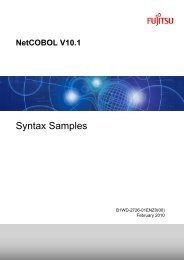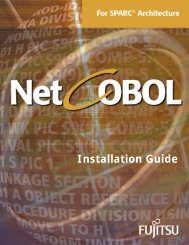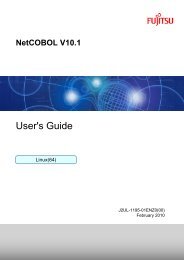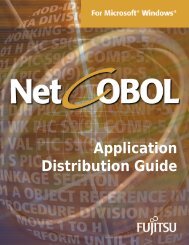NetCOBOL for SPARC Architecture SAF Subroutines User's Guide
NetCOBOL for SPARC Architecture SAF Subroutines User's Guide
NetCOBOL for SPARC Architecture SAF Subroutines User's Guide
Create successful ePaper yourself
Turn your PDF publications into a flip-book with our unique Google optimized e-Paper software.
12 Chapter 2. Creating Web Applications Using <strong>SAF</strong> <strong>Subroutines</strong><br />
Web Page <strong>for</strong> Invoking Application<br />
Prepare a normal HTML document. To start the Web application, however, use the<br />
tag or tag.<br />
Example:<br />
When executing the generated dynamic link library <strong>SAF</strong>.dll in METHOD = "POST"<br />
<br />
Note: When the Web application is started by using an tag, the Web<br />
parameter list cannot be obtained by the program.<br />
Make a setting on NES so that the extension “apl1” would correspond to <strong>SAF</strong> .dll<br />
containing the application. For details, see "NES setup" in Chapter 4 .<br />
For explanations concerning other HTML documents, see Appendix A of "<strong>NetCOBOL</strong><br />
Web <strong>Guide</strong>."<br />
Web Page <strong>for</strong> Processing Result Output<br />
The Web page <strong>for</strong> processing result output is an HTML document <strong>for</strong> returning the<br />
result of the Web application to the WWW browser. It is not necessary to create a<br />
Web page <strong>for</strong> processing result output because the response data, including the<br />
requisite HTML, can be returned directly from the Web application. If the Web page<br />
<strong>for</strong> processing result output is separate from the application program, however, then<br />
it is possible to change the layout of the output results without recompiling the Web<br />
application.<br />
To output the static HTML document (HTML document whose output data does not<br />
change due to process results), it is possible to use the HTML document generated<br />
with the HTML generation tool.<br />
It is also possible to dynamically change the <strong>for</strong>mat of the Web page <strong>for</strong> processing<br />
result output .<br />
Specifying the item name (conversion name) enclosed with "//COBOL//" on the<br />
output Web page enables dynamic data conversion . Since all data in an HTML<br />
document can be a target <strong>for</strong> replacement, it is also possible to replace a tag <strong>for</strong><br />
changing text or specifying the background color. For details, see<br />
"COBW3_PUT_HTML" in Chapter 3 "Processing result output."<br />
It is also possible to divide the title/statement/header into multiple HTML documents<br />
<strong>for</strong> output and to output the divided document in combination with plain text.<br />
Notes:<br />
• Do not use the following functions related to screen operation in the COBOL<br />
program to be used in the Web application. For details, see Chapter 21<br />
"Programs Running under a Service" in "<strong>NetCOBOL</strong> <strong>User's</strong> <strong>Guide</strong>."<br />
- Presentation file module (Screen handling module)<br />
- Screen handling module<br />
- ACCEPT/DISPLAY function<br />
(Modules handling environment variables, dates, and time, however, can be<br />
used.)







